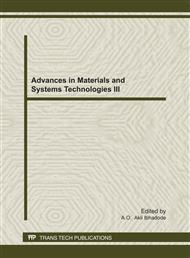p.507
p.517
p.525
p.537
p.547
p.555
p.561
p.567
p.575
Property Analysis for Correlation of Specific Energy with Penetration Rate and Bit Wear Rate
Abstract:
This study evaluates rock properties for correlation of specific energy with penetration rate and bit wear rate. In order to achieve these objectives five rock samples were obtained from the study area. These samples were tested in the laboratory for uniaxial compressive strength and tensile strength using 1100kN compression machine and point load tester respectively. Also, the mineral composition of the samples was determined by thin section examination. Bit deterioration was measured with digital vernier calliper at regular intervals. The specific energy was determined from field data using empirical equations. The results of the uniaxial compressive strength of the five rock samples varied from 165-320 MPa and were classified as having very high compressive strength characteristics. The point load strength index of the samples had values ranging from 5.50 – 10.67 MPa representing the tensile strength. The result of the statistical correlation matrix revealed that penetration rate and bit wear rate are dominant factors affecting the prediction of specific energy having high coefficient of correlation. The regression model had multiple coefficient of correlation of R2 = 0.893 which means that 89.3% of variation in specific energy could be attributed to variation in penetration rate and bit wear rate. Ultimately, computer programme DRILLING PROFESSIONAL 2009 was developed to compute penetration rate, wear rate and specific energy when necessary inputs are supplied. This gives quarry operators advance information on time of drilling and bit consumption.
Info:
Periodical:
Pages:
547-553
Citation:
Online since:
October 2011
Authors:
Keywords:
Price:
Сopyright:
© 2012 Trans Tech Publications Ltd. All Rights Reserved
Share:
Citation:


